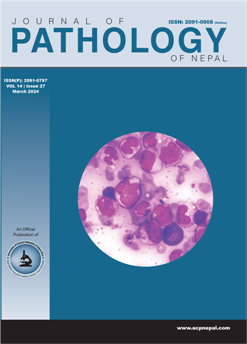Study of placenta histopathology in low birth weight deliveries: A prospective cross-sectional study at Nobel Medical College Teaching Hospital
DOI:
https://doi.org/10.3126/jpn.v14i1.66310Keywords:
Chorioamnionitis; Low birth weight; Placenta; Pregnancy;Abstract
Background: Placenta is the most important organ that represents the status of the mother and fetus. Its examination on gross and microscopy can reveal varied pregnancy-related diseases, decreasing future adverse pregnancy outcomes. This study aims to examine the placenta histopathologically among low birth weight pregnancies.
Materials and methods: A prospective case-control study was conducted in the Department of Pathology over one year. The placenta of low birth weight (weight < 2.5 kg) term pregnancies were histopathologically examined. The maternal demographics, co-morbidity, gravida, and hemoglobin levels were recorded. Descriptive statistics, and student t-test or Chi-square test were used for two-group analysis.
Results: Thirty-two consecutive patients enrolled in each group. A significant proportion of the patients in the study group were anemic (9.2 vs. 11.5 gm/dl; p=0.03). Pregnancy-induced hypertension rate was significantly higher in the study group (31% vs. 9%; p = 0.042). Gross observations in low birth weight pregnancies were sub-chorionic fibrin deposition (75%), calcification (37%) and infarction (31%). On microscopy, chorionic vessel thrombosis was significantly higher in the study group (56% vs. 6%; p= 0.003). Furthermore, chorioamnionitis (34%) and placental floor infarction (12%) were also observed in a significantly higher number of placentas in the study group.
Conclusions: Anemia and pregnancy-induced hypertension are important associated factors for low birth weight pregnancies. Pathological examinations reveal higher fibrin deposition, infarction, calcification, sub-chronic vessel thrombosis, and chorioamnionitis in low birth weight placenta.
Downloads
Downloads
Published
How to Cite
Issue
Section
License
Copyright (c) 2024 The Author(s)

This work is licensed under a Creative Commons Attribution 4.0 International License.
This license enables reusers to distribute, remix, adapt, and build upon the material in any medium or format, so long as attribution is given to the creator. The license allows for commercial use.




